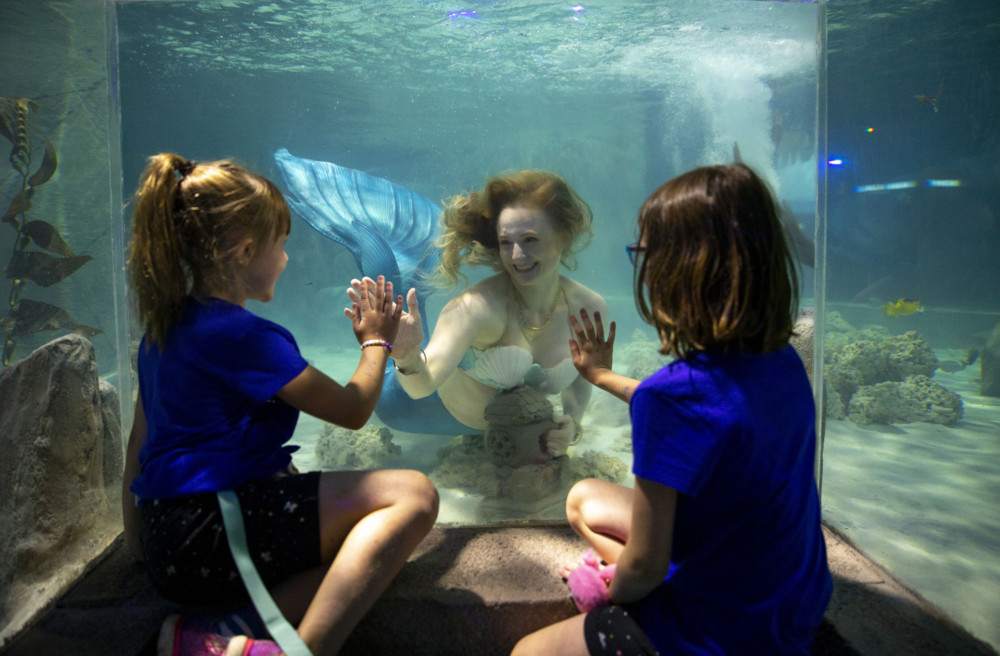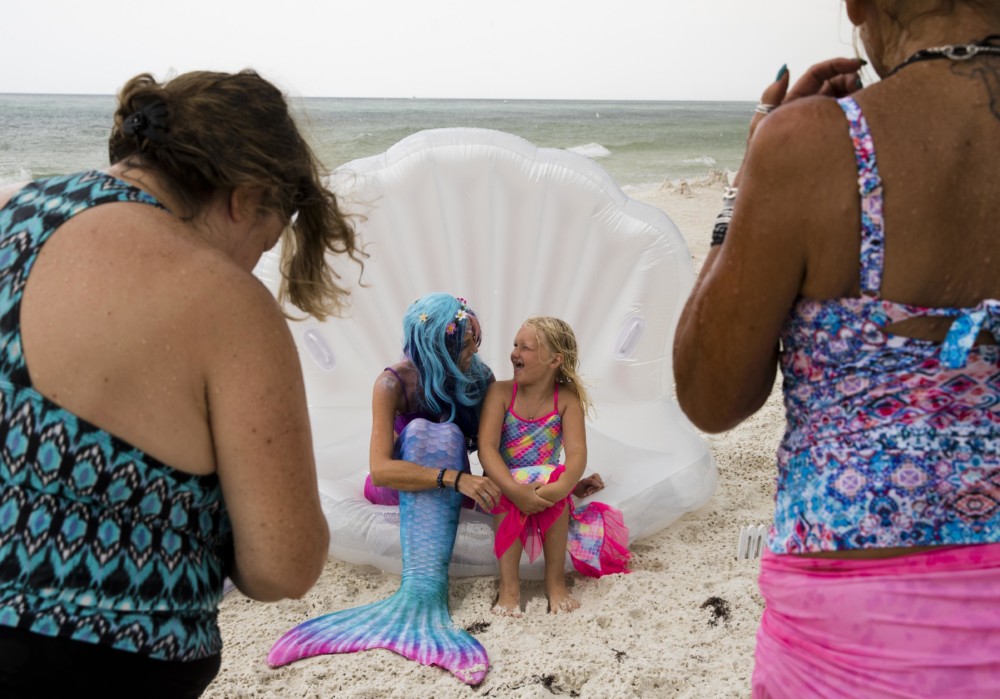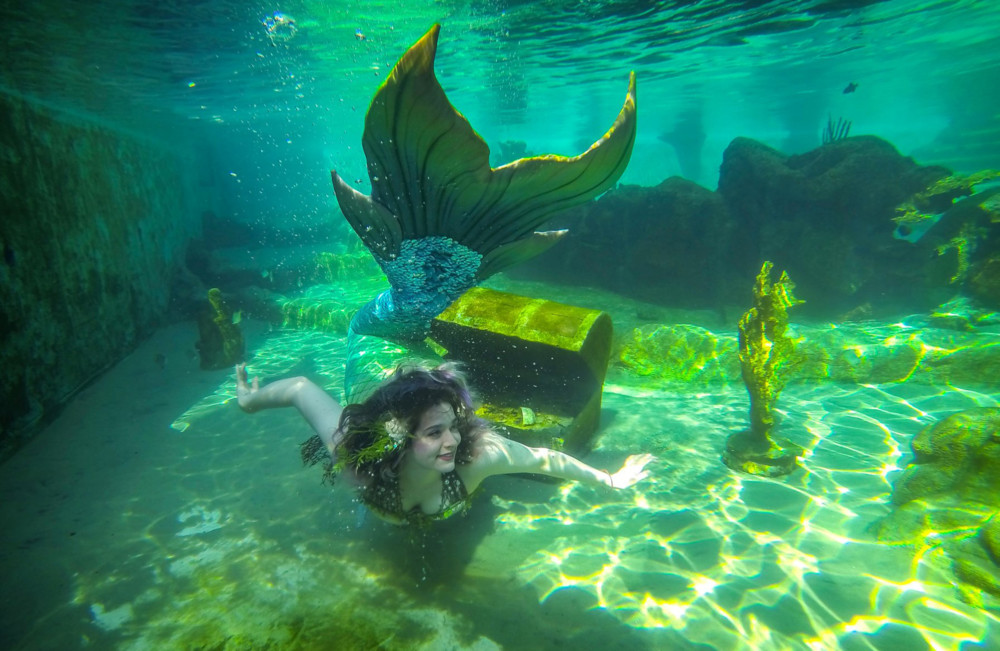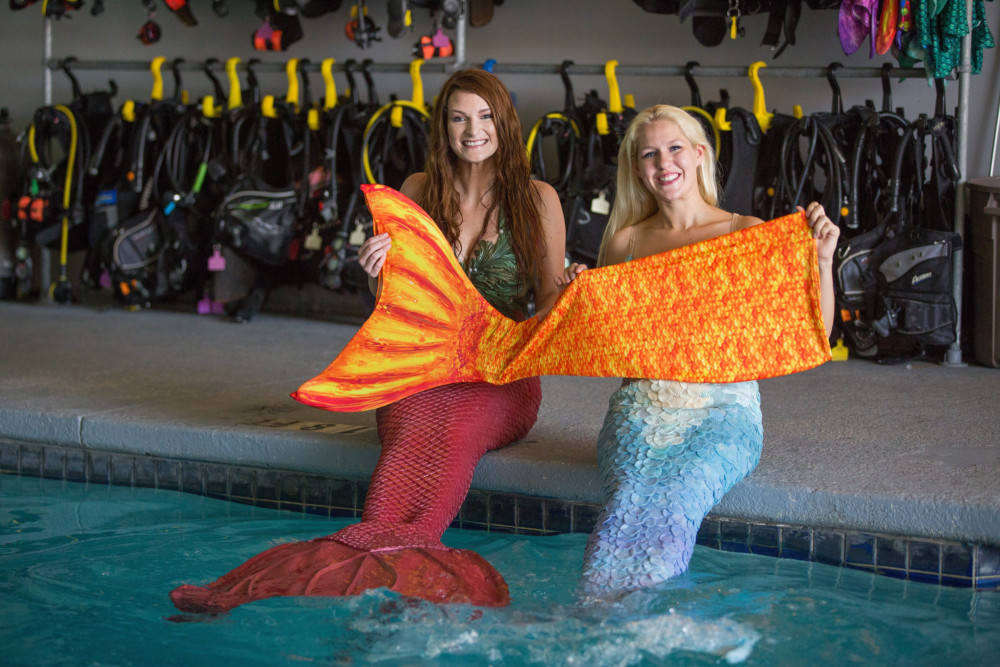By Erica Pearson
Star Tribune (Minneapolis)
WWR Article Summary (tl;dr) As Erica Pearson reports, “Mermaiding,” is a growing hobby and profession, thanks to lifelike silicone and fabric tails, online communities (called “pods”) and our enduring fascination with the mythical creatures.
Star Tribune (Minneapolis)
As a little girl, Lindsey Stupica was obsessed with mermaids. Disney’s Ariel was her favorite character. Anytime she dove into a lake or pool, she would clamp her legs together and do a dolphin kick to glide underwater, holding her breath for as long as she could.
Now she regularly swims with rays and sharks as one of six aquarium mermaids at SeaQuest inside the Rosedale Center mall.
Her 25-pound silicone tail can be tough to wriggle into, bathroom breaks require a trip on a cart and kids sometimes stomp on her tail to see if she’s real. Still, she finds magic in every shift.
“It’s been a wonderful thing to go out and chase my unconventional dream,” she said.
“Mermaiding,” as Stupica, 37, calls it, is a growing hobby and profession, thanks to lifelike silicone and fabric tails, online communities (called “pods”) and our enduring fascination with the mythical creatures.
As buzz builds over Disney’s upcoming live-action remake of “The Little Mermaid,” and mermaid-themed birthday party supplies crowd out the unicorn goods at Target, it’s easier than ever for people to turn themselves into a mermaid or merman.
In the Twin Cities, more than 40 enthusiasts have joined a Facebook group called Minnesota Merfolk, where they plan meetups at tail-friendly pools, lakes and aquatic centers in the area. In St. Louis Park, Sabes Jewish Community Center is even offering “Mermaid University” classes this summer so that wannabes can try out a tail and become certified to wear one during the center’s public swim time. (Mermaid tails, which run from about $250 for neoprene fabric versions to more than $5,000 for a custom silicone tail, are only recommended for folks who are already strong swimmers.)
Some of the most lifelike tails are crafted by a company with Twin Cities roots. FinFolk Productions, now based in North Carolina, was started several years ago by two St. Paul sisters who initially created silicone tails in 2012 for a Minnesota Renaissance Festival mermaid show. The “mermaid cove” is now a regular part of the yearly Ren Fest, providing seasonal work for professional merfolk.
UNDERWATER KISSES
“Mermaid coming through, everyone!” called a worker during one of Stupica’s recent shifts at SeaQuest, where she has been a resident mermaid since the two-story aquarium and small-animal exhibit opened in May.
buy eriacta generic buy eriacta online no prescription
Stupica sat on a cart with her tail fanned out as two staffers in blue polo shirts wheeled her from her dressing room to the giant concrete clamshell in the aquarium’s Caribbean Cove.
Once there, she hoisted herself up onto a pillow, and spent the first few hours of her four-hour shift greeting kids, smiling for photos and painting faces with unicorns and flowers.
At SeaQuest, which has 10 locations in the U.S., the mermaids (“We’re all named Marina,” Stupica explained) don’t break character. They’re displayed like any another creature in the exhibit, following the Asian small-clawed otters and California round rays and before the two-toed sloth.
An electronic sign near the giant shell displays “facts” about the “Atlantis Mermaid,” including: “Mermaids don’t just live in oceans and reefs. Depending on the species of merfolk, they can be found by waterfalls, rivers and even fountains.”
The dry land part of the gig had a department store Santa feel, as Stupica worked to keep the magic alive for a line of children.
Some little visitors shouted “Mom! It’s a mermaid!” and ran up to give her a high five while others, unsure at what they were seeing, would only peek out from behind a parent’s knee.
Older kids just walked past, while grade schoolers puzzled over her tail. When one asked, “Are you really a mermaid?” Stupica replied “I am!” with a big smile and flipped her tail up and down.
Stupica’s favorite part of the shift is the last hour. That’s when she glides around the saltwater aquarium like a performer from Florida’s famed Weeki Wachee Springs mermaid show. (First, though, she needs help from a co-worker or two to get into the tank, sliding herself up a scaffolding of yoga mats and into the water without attracting too much attention from onlookers.)
During a recent visit, she petted the friendly bat rays and swam down to a glass tunnel to blow underwater kisses at kids on the other side of the glass. She spent only about 20 seconds underwater during each dive, but for many of the mesmerized children watching, it looked like an impossibly long time.
Seven-year-olds Maria Donnay and Savanna Pieper, friends from school spending an afternoon at the aquarium with their moms, couldn’t turn away.
“Wow! Look!” Maria exclaimed as the pair rushed down to touch their hands to Stupica’s through the glass.
Once she surfaced at the top of the tank, the girls ran over to her. When Maria asked, “How did you get to be a mermaid?” Stupica was quick to reply: “I was born this way.”
MODERN MERMAIDING
With an hourly rate a notch above minimum wage, being an aquarium mermaid may be Stupica’s day job, but it isn’t her only one. She’s also an animation professor at Minneapolis College of Art and Design as well as an illustrator and designer. For her, mermaiding is about more than a paycheck.
“I felt a little self-conscious when I started, asking myself, ‘Is this silly?’ ” she said. “It’s bringing joy to kids. It’s hard work but it’s very fulfilling.”
Stupica is fairly new to wearing the tail. She discovered the world of modern mermaiding a few years back, when her daughter became entranced by YouTube videos by an Australian marine conservation activist named Hannah Fraser, who dons a tail to free-dive underwater as “Hannah Mermaid.”
At first, Stupica wished she could have tried out one of the lifelike, silicone tails during the height of her own childhood mermaid obsession. Then, she searched for other merfolk on Instagram and Facebook, becoming one of the 230,000 followers of @finfolkproductions.
“There’s a giant mermaid community out there,” she said. “The community is really supportive.”
She spent a few years following other merfolk on social media. But this past winter, she decided to spring for a $350 fabric tail and a $150 monofin “as a treat,” which quickly led to her job at SeaQuest.
The first time in the water with the tail, she planned to meet up with a few more practiced mermaids at St. Paul’s Great River Water Park. She was the first to arrive, and felt a little awkward standing there on the deck, holding her tail.
“I was feeling self-conscious, and people were staring at me. But I thought, this is something I really want to do,” she said.
“So I put it on, and got into the water and immediately just felt like a kid again. I was filled with glee, and childlike wonder, and it just was so awesome. It was such a cool feeling, that’s really never been lost.”
Since then, she’s upgraded to a $1,500 silicone tail and is planning to take a diving course.
Recently, her daughter, now 18, came to visit her at work. The teen captured photos and videos of her mom gracefully swimming laps around the SeaQuest tank. Stupica posted a few of the images to Instagram, adding a caption of her own: “Living. My. Dreams!!!!”
___
Distributed by Tribune Content Agency, LLC.

















































































































































































































































































































































































